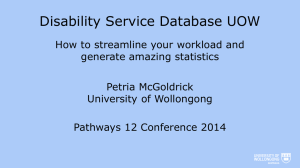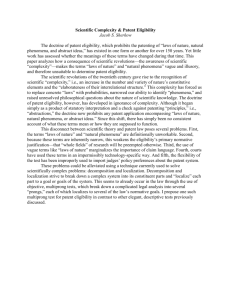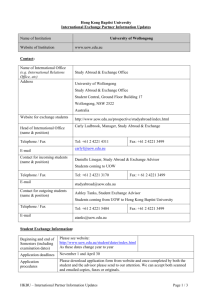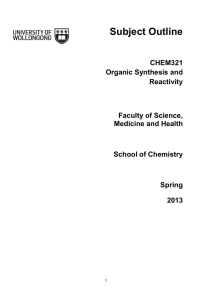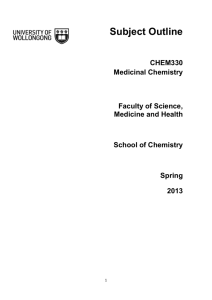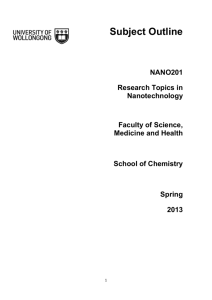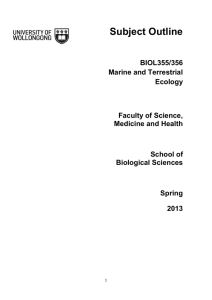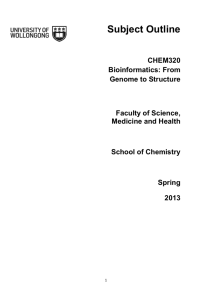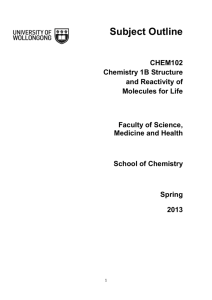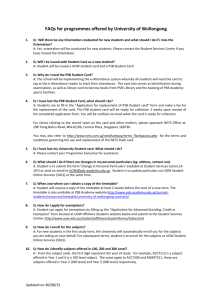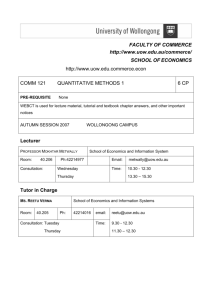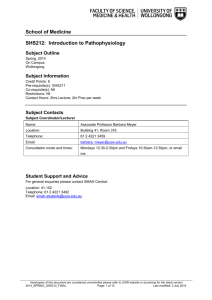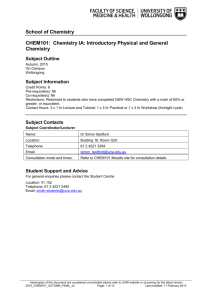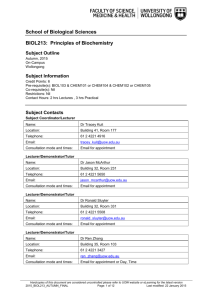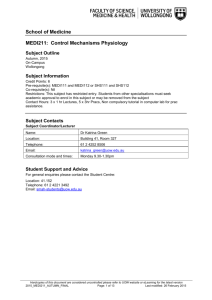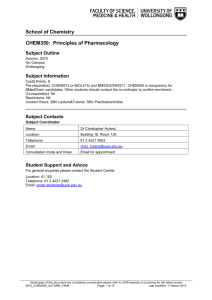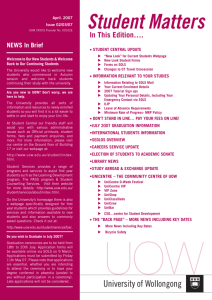Submission 54 - University of Wollongong
advertisement
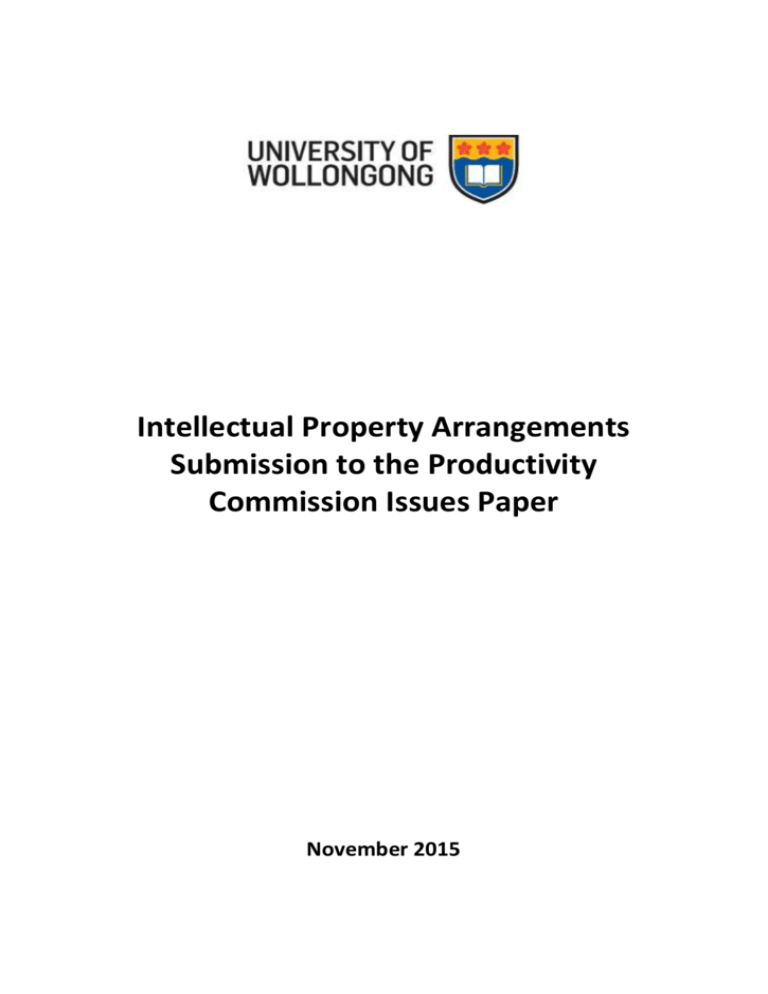
Intellectual Property Arrangements Submission to the Productivity Commission Issues Paper November 2015 The University of Wollongong (UOW) is pleased to have this opportunity to respond to the Productivity Commission’s Issues Paper on Intellectual Property Arrangements. UOW is a comprehensive, research intensive institution. The University currently employs 1,032 FTE academic staff involved in research-related roles. Over 1671 higher degree research students are currently enrolled at UOW and in 2014, 290 PhD and Masters (Research) students graduated. UOW has consistently delivered research of outstanding quality and impact, as evidenced by our placement in the top 2% of QS and Times Higher Education world university rankings. The dissemination of our research to user communities, including industry, is one of UOW’s key goals and we have a justifiably strong reputation for our engagement with industry. UOW has a specialised Innovation and Commercial Research team driven by the belief that research can have an immense impact on innovation through relevant engagement with business, industry, government and the community at large. The team works with these external partners in developing state of the art technology solutions and assists researchers seeking to commercialise their research. In addition to the Innovation and Commercial Research team, UOW’s Commercialisation Managers work closely with researchers to identify ideas which have real commercial potential. UOW also works with businesses and investors to protect and commercialise the latest in UOW’s technologies. UOW is aware of the increasing need for universities and industry to work together in fostering research and innovation in Australia, and views discussion around intellectual property as an important element in creating a successful collaboration between the two. The UOW response concerns select points raised in the issues paper as follows: To what extent does the IP system actively disseminate innovation and creative output? Does it do so sufficiently and what evidence is there of this? How could the diffusion of knowledgebased assets be improved, without adversely impacting the incentive to create? The issue of publishing versus patents has an adverse impact on early career researchers. One perspective puts the issue down to a matter of career vs money; however the issue has far reaching implications and goes into the sphere of innovation, and the ways in which it can be stifled. Australia ranks at the bottom of the OECD group of advanced economies in terms of collaboration between its university research sector and business, particularly in small to medium enterprises. There are a variety of ways in which this issue could be addressed, and how Universities in other countries successfully start their relationships with SMEs may provide some answers. For example, Caltech gives licensing preferences to start-ups, both to avoid the possibility of a big company’s shelving of the technology and to increase commercialization of the technology. Caltech rarely asks for up-front payment fees (especially from a start-up), 2 allows for options giving entrepreneurs time to raise money, accepts equity as an up-front payment and does not require reimbursement of patent legal fees. What additional challenges does technological change and new methods of diffusion, including digitisation, present for the adaptability of the IP system? How should such challenges be approached? The gap between technological advancement and the laws that may govern them is rapidly expanding. Scott Brinker of chiefmartec.com comments on the issue that we haven’t come to grips with what is ethical, let alone with what should be, for technologies such as social media. He goes on to say ‘it’s reasonable to suggest that the velocity of technology change can be characterized as something faster than steady or linear growth, whereas laws, typically, ‘absorb’ change logarithmically. It takes the legal system much greater time to understand, deliberate and execute.’ Brinker states that ‘one of the great dilemmas of the 21st century is the relationship between these two curves… The simple fact is that technology is changing much faster than laws can absorb change.’ It is important to note that it is not those in the legal profession who will have the expertise to guide these changes alone – experts in the field, innovators and entrepreneurs need to be a part of that process. Are there aspects of Australia’s patent system that act as a barrier to innovation and growth? If so, how could these barriers be addressed? The accessibility and costs of patenting in Australia is restrictive to SMEs. Paula Chavez, an American patent lawyer now working with Australian firm Wrays, says a lot of the problem lies in the cost of filing in Australia, which is much higher than in the US. A patent application in the US can cost around $2000-$3000; in Australia it's at least $10,000. Also she says it's harder and more expensive to sue in Australia to protect your IP, because the loser pays the legal costs of the winner, which is not the case in the US (Kohler 2014). Ian Maxwell, an adjunct professor at RMIT University, recently wrote that ‘any patent application expenditure is highly speculative because there is no certainty future economic benefits will flow to an entity which owns a patent application. ‘ He proposes that since patent applications have no value prior to the granting of a patent, a tax break for patents that allows all patenting cost to be expensed for tax purposes up until when a patent is granted (in a jurisdiction) whereupon further costs (of maintenance over the life of a patent) should be treated as capital expenses. Maxwell goes further and proposes allowing costs associated with patent applications to be eligible for the R&D tax concession as an enabler for bringing the patenting process properly into the R&D process; treating patent application costs as R&D expenses would reduce the perceived costs and risks of patenting and hence encourage both innovation and patenting. 3 References Maxwell, I 2014, Grants aren’t helping Australian tech, but patent reform could, accessed November 2015 https://theconversation.com/grants-arent-helping-australian-tech-but-patentreform-could-30254 Kohler, A 2014, Australians need to get patenting, accessed November 2015 http://www.abc.net.au/news/2014-12-04/kohler-australians-need-to-get-patenting/5937370 Brinker, S 2013, Martec’s Law: Technology changes exponentially, organizations change logarithmically, accessed November 2015 < http://chiefmartec.com/2013/06/martecs-lawtechnology-changes-exponentially-organizations-change-logarithmically/> For further information on this submission please contact Canio Fierravanti Director of Government Relations. 4
